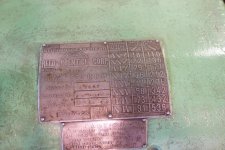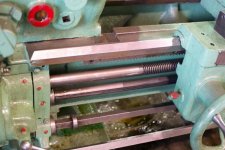As a matter of safe working practice, I like to put a local disconnect switch between my machine tools and the connection to electric power. This switch is in ADDITION to the actual control switch on the machine tool. The local disconnect ( a powerplant term) is what is also known as an "enclosed safety switch". If I am going to leave the machine tool when done working on it, I open the disconnect. If I am going to be changing tooling or a chuck, I open the disconnect. On my Bridgeport mill, the drum switch is right up close to the top of the head, and when I reach for the brake lever to hold the spindle while putting a wrench on the drawbar, I can see where it might be possible to hit the drum switch by mistake. On my LeBlond lathe, I am installing a local disconnect switch between the line and the drum/reversing switch. Some of my machine tools have the later style pushbutton switches, where you have to stick your finger into a recess to push the "on" button, so I do not run disconnect switches on them.
As I get older, I get more conscious of safety. I've got some scars and a maimed finger to show for over 40 years around machinery, I'm a bit hard of hearing, but otherwise intact. I work alone in my shop, live out in the woods, so taking a little extra step to make things safer is something I've been doing more of as I get older.
The old lathes were built during an era when people more commonly worked around machinery. It was an era when people were expected to have common sense and to look out for themselves, to know where their bodies began and ended and where all their body parts were at. No safety stickers stating the obvious, very few, if any guards, and none of the safety interlocks or emergency shutdown/panic brakes we see on today's machine tools. In short, it is up to you to work safely and never to become complacent out of familiarity with the machine tools.
In the 1960's, we went through Brooklyn Technical HS running machine tools from the 1920's-40's. No special additional guards or safety features were on those machine tools. We ran flat-belt driven lathes and mills and shapers, and we ran engine lathes just like your R & P. We were kids of 14 or so, and we were tickled and happy to be learning machine shop work. There were literally tens of thousands of boys who went thru Brooklyn Technical HS (max enrollement was 6,000 boys). I do not recall any serious injury, nothing beyond maybe a bad cut or some bruises. We learned simple things to do to work safe. Stuff that would seem so obvious, yet people overlook it. Example: you are going to be setting up a job on a faceplate or in a 4 jaw chuck. Take the time to remove the toolbit or toolholder and tailstock center before you find either of them "the hard way".
Or, the chip is curling off your tool as you take a heavy cut. Looks kind of mesmerizing, you get to thinking "how long a chip can I get going here ?". You absentmindedly heft the chip with your hand.... and the place looks like the killing floor in the local slaughterhouse just that quick, only it's your blood all over the place. As recently as 4 or 5 years ago, I did just this self same thing while turning down a hunk of O-1. I saw the gash, got a clean shop wipe on it and finished the cut. Shut down the lathe and asked my wife had to run me to the local ER. It took 4 stitches to close the cut that chip of steel put into my finger.
Another thing we were taught as kids in HS: when you are done making your setup of a job in a lathe, put the headstock "between gears" (equivalent of "neutral" on a manual car or truck transmission). Roll the spindle over by hand to make sure everything clears. Bring the carriage up to the extreme ends of what your cut will be to be sure it does not crowd the tailstock or run into the chuck. If you look at most older used lathes, the front LH corner of the topslide (compound) will have some serious gashing or chewing up. This is from people running it into the chuck jaws. This is what is known as a "crash". A minor crash results in damage like some metal off the compound. A serious crash results in stripped gears or worse.
If you set a large or odd-shaped job up on the faceplate or four jaw chuck, make sure it clears the bed ways as well as the compound. A little extra care up front can prevent a lot of damage. Damage like a crash can happen in less than the blink of an eye when you throw in the clutch. A lathe like the R & P will not give you much "forgiveness". No flat belt to slip, no fractional HP motor to lug down. A R & P lathe has the beef to eat itself alive if you have a crash. You work slowly, think about each move,pull the spindle over by hand to check for potential crashes, and you will not go too wrong. If you are going to cut threads, make some practice runs with the carriage out in the middle of the bed and no work in the lathe. Get a sense of how fast the carriage will be travelling when you engage the half nuts. Get comfortable and "automatic" as to engaging or disengaging the half nuts.
A lot of machine tools contributed to the WWII effort. More than we might ever imagine. Many were built to "War Production Board" or "War Finish" standards as part of common lots. Many were shipped directly to our allies. Our machine tools went to Russia, France, and to England and as far afield as Australia and New Zealand during WWII. Our machine tools were installed aboard naval and merchant vessels. Any time I see the "anchor" acceptance stamp on an older machine tool, I always wonder: "Did this lathe (or mill or shaper) go to sea ? Did it wind up in some naval shipyard or on a base far from the mainland USA ?" We tooled up our allies for WWII, and even before WWII, our future enemies were buying our machine tools. After WWII, our machine tools went to re-establish industry in war torn areas. Design features used on our machine tools were often adopted by foreign manufacturers when they began manufacturing machine tools. It's interesting to think about the impact our machine tool industry had on the world.
As a side note: my own LeBlond lathe was shipped in July of 1943. LeBlond records tell that it was shipped directly to an engineering firm within 30 miles of my house. That firm was (and still is) making specialized filters. During WWII, the bulk of their filter production was for the pharmaceutical industry, for plants producing penicillin. Some of the tooling still with my LeBlond lathe was shop made, specific to machining thin-wall tubes as would be used for filter cannisters. Lathes with "anchor" could have been in so many possible places. A lot of lathes and machine tools got the government acceptance stamp during WWII and were assigned to defense contractors' plants. Tracking down where a machine tool was first used or where it went is nearly impossible when the maker is completely history (as is Reed and Prentice). I know that when our son was looking at colleges, we went to Worcester, MA to look at Clark University. It was right in the city of Worcester. That part of Worcester looked like it had seen its best days years before (to be polite). I remember looking around Worcester for some sign of where Reed & Prentice had been, or Norton's grinding machine plant, and not seeing anything obvious. It was all burnt out, boarded up, and dejected. Our son went to Hobart, in the Finger Lakes, so I never did get back to poke around Worcester, MA. New England was the cradle of the US Machine Tool Industry, but the real mature powerhouse of our machine tool industry (and machine tool capital of the world) was Cincinnati. R & P was kind of a holdover from the early days of the machine tool industry, remaining in New England.





